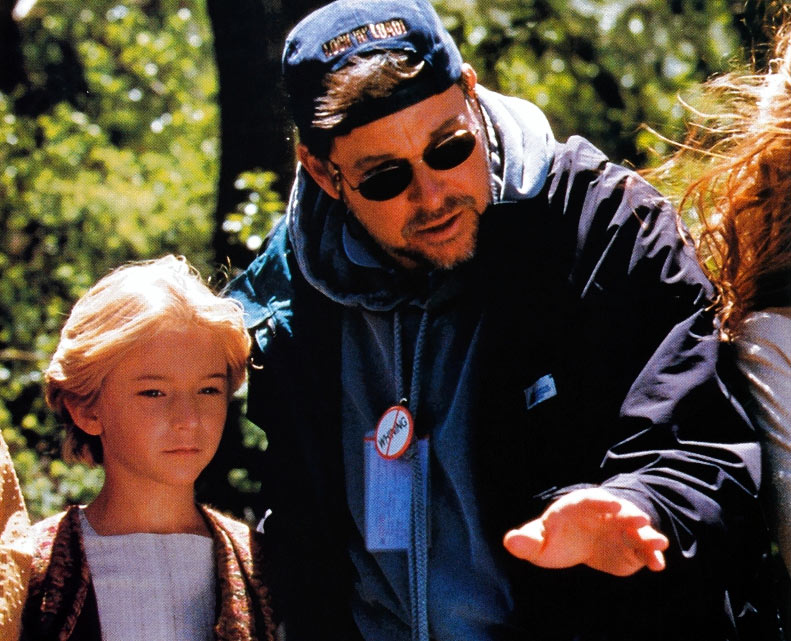Star Trek: Insurrection, arguably the most underrated and misunderstood film of the Star Trek oeuvre, turns 20 years old this month. So, yew-cheen chef-faw, everybody (emphasis on the cheen!) — it’s time to recognize this underappreciated Trek masterpiece.
Capturing the sweet spot of Star Trek storytelling with a strong morality tale, important character development, and loads of action and strong visual effects, Star Trek: Insurrection never received the credit it deserves for being a defining slice of the Star Trek pie.
https://www.youtube.com/watch?v=-PvErkoMSEo
Certainly the timing of Insurrection’s release is one of the reasons the film is underappreciated, as it came out as Trek’s production peak of the 1990s was coming to an end.
When Insurrection hit theaters on Dec. 11, 1998, to middling reviews and a soft box office, Trek was beginning its nadir away from the limelight. Deep Space Nine was just a few months away from going off the air, which would end Trek’s strong six-year run of having two shows and multiple films all in production at the same time; and Voyager, followed by Enterprise, would conclude in 2005 after 17 consecutive years of Trek on TV with dwindling ratings and buzz.
Insurrection is a rousing two-hour episode of Star Trek: The Next Generation, told on a major motion picture budget, with all the action, humor and ethos that have made Star Trek the venerable 52-year old franchise it is.
“In six hours, every living thing in this system will be dead or dying.”
Almost every single episode of Star Trek takes place very far away from Earth, but somehow it took 20 years and nine movies for a Star Trek film to get deep into space with no sign of Earth anywhere on sensors.
Until Insurrection. It is a different kind of Star Trek film. There’s no imminent threat to Earth. The Federation is not under siege. There’s no “search” for resurrection, vengeance or retribution. It’s a smaller film in terms of story and scope, and that is precisely where its success lies.

Coming out just two years after the major critical and creative success of Star Trek: First Contact, it became clear early on that a change of pace was needed when the ninth Trek film was green-lit by Paramount. Longtime Next Generation and Voyager writer/producer Michael Piller, the man most responsible for the success of TNG after his arrival in 1989, was charged with creating the story for the film.
“How do you ‘out-Borg’ the Borg?” said the late Piller in a production interview about the film. “How do you create a villain or adversary the will be their equal? The answer is you don’t try. Make a different kind of movie.”
Piller’s original premise for the Insurrection featured Captain Picard (Patrick Stewart) on the hunt for an old Academy classmate gone rogue, an idea that then morphed into a Heart of Darkness–style showdown between Picard and Data (Brent Spiner). And then that framework was whittled down even more. The ebb and flow of the overall creative process in making the film is chronicled in incredible detail in his book Fade In — The Making of Star Trek: Insurrection, which was published posthumously by his wife, Sandra Piller, and highlights the way writers had to often navigate studio decision makers to get to a final product.
“We’re through running from these bastards!”
Under the watchful eye of director Jonathan Frakes, Insurrection is packed with energizing action set pieces that stand the test of time and certainly don’t get the credit they deserve.
The opening duck blind scene on the Ba’ku planet is strikingly visual and beautifully shot by Frakes, who also plays Commander Will Riker in the film. With its callback to the great TNG episode “Who Watches the Watchers,” it drops the audience straight into a mystery that unravels satisfyingly across the next two hours.
The distinctive sight of the cloaked Data slowly being revealed to the Ba’ku is among the most memorable scenes in the film for the way it uses modern effects and Starfleet technology juxtaposed against an idyllic and seemingly technologically-primitive society.

That opening intrigue is followed closely by what can only be described as the “Gilbert and Sullivan chase.” Yep, it’s the one where Picard and Worf (Michael Dorn) sing Gilbert and Sullivan’s “A British Tar” to try and get through to Data and snap his programming back into place. The sequence is an exemplary illustration of what Trek does with astonishing success: broad humor.
Sure, everyone loves when Trek gets deep into the mythos with stories about the Dominion War or the Borg or stoic Vulcan mysticism, but some of Trek’s most popular and acclaimed episodes are comedies. From “The Trouble with Tribbles” to The Voyage Home to “Bride of Chaotica!,” Trek’s sense of humor cannot be dismissed. And Insurrection’s playfulness was cut from the same cloth as “A Piece of the Action” and “Take Me Out to the Holosuite.”
“I’ve never seen a sunrise. At least, not the way you see them.”
Where the film admittedly suffers slightly is in the climactic battle between Picard and guest villain Ru’afo (F. Murray Abraham), which, despite some late restructuring, is fairly paint-by-numbers and steals plot points from a couple of late-season Next Generation episodes (most notably “Ship in a Bottle” and “Homeward”).
But it does give us the unforgettable image of the Sovereign-class Enterprise-E sweeping across the face of the collector as it explodes, beaming Picard to safety at the last second. (And, sure, if you are a nitpicker you can complain all you want about the ship’s mismatched size ratio compared to the Son’a collector. But while you’re doing that, I’ll be munching on my popcorn and having a blast.)

And if space battles are your thing, the Enterprise squaring off against the Son’a ships in the Briar Patch is as underrated as it gets. Seeing Riker go through the paces of command and eventually come out on top in a well-articulated battle, with easy-to-follow motivations and great pacing (plus one joystick-fueled ‘Riker Maneuver’) is a worthy highlight of any Trek film.
Much in the same way as the actual film told a smaller and more intimate story, the fourth of composer Jerry Goldsmith’s five Star Trek film scores was also a refreshing change of pace. From the opening theme, “Ba’ku Village,” to the underrated (and aforementioned) “The Riker Maneuver,” Goldsmith’s soft, musical design for Insurrection sounds like no Trek before or since.
“I wonder if you’re aware of the trust you enGENDER, Jean-Luc Picard.”
“I think this film is a more romantic film than any of the others have been,” said the late Goldsmith of his score. “So that makes it a little different for me.”
Goldsmith’s score is a perfect complement for the film, with a lighter balance that has only enhanced its place in Trek’s musical pantheon across the past 20 years.
The entire Next Gen ensemble is rewarded during the film’s two-hour running time with prominent character development moments tethered to the influence of the metaphasic rings around Ba’ku. From Geordi’s (LeVar Burton) view of a sunrise to Riker and Troi (Marina Sirtis) rekindling their old flame, the fountain of youth emanating from the Ba’ku planet touches each character and underscores everything happening in the film.

That quest for eternal youth becomes all the more poignant when Dr. Crusher (Gates McFadden) realizes the Son’a and the Ba’ku are the same race, with the former manipulating the Federation to try and return home and harness the metaphasic radiation in the rings surrounding their home world. The tragic juxtaposition between Anij (Donna Murphy) and Ru’afo magnifies the choices our TNG heroes have made in their own lives: and how much lost youth they can reclaim as they feel the energizing effects from being around the Ba’ku.
“How many people does it take, Admiral, before it becomes wrong?”
Ultimately, the answer to that question comes in the form of an android and a little boy playing in a haystack. “Don’t forget. You have to have a little fun every day,” Artim (Michael Welch) tells Data at the film’s conclusion.
Sure, it’s a little bit hokey. (OK, maybe a lot a bit hokey.) But that doesn’t make its message any less powerful (and it is one taken to heart by Trek’s first couple, as the next time we see them in Star Trek: Nemesis, Riker and Troi are finally together and getting married).
With our Trek favorites firing on all cylinders in this film, the production is wonderfully enhanced by a sensational guest cast including three award-winning stage actors in Oscar-winner F. Murray Abraham, Tony Award-winner Donna Murphy, and Emmy Award-winner Anthony Zerbe taking on the role of the gruff Admiral Dougherty.

All three provide unique takes on what could have been standard Trek tropes — especially Murphy, who examines a “perfect moment in time” as a love interest for Picard that balances a curious line between smoldering pursuit and take-it-or-leave-it passivity. As if to enhance that fact even more, Picard and Anji never even share a kiss on screen, which is certainly not the typical way Hollywood frames a romantic lead (although they do kiss in a wisely deleted extra scene).
As for Abraham’s Ru’afo and Zerbe’s Dougherty, they could certainly be critiqued as standard Trek “big bads” and “badmirals,” but that would discount the broad strokes both actors bring to their roles. Ru’afo feels over-sized and manic on the big screen, while Zerbe’s “Ssssend your sssships.” exasperation is an unforgettable Trek betrayal.
The film was released to average reviews, and it grossed just $119 million worldwide. Adjusted for inflation, its box office totals rank it 11th out of 13 Star Trek films.
“Where can warp drive take us, except away from here?”
Unfortunately, part of the fallout from that generally poor reception was losing Frakes as director for the follow-up, Star Trek: Nemesis. Frakes’ deft guidance could have saved that film from the hands of the Trek-ignorant director Stuart Baird, a bad fit for Star Trek from the start. But that’s a story we’ll tackle when we look back on Nemesis after 20 years.
https://www.youtube.com/watch?v=ZIWxT_WYyaw
For now, watch Insurrection with a fresh set of eyes. Don’t think of it as a once-every-few-years Major Motion Picture Event!, but instead view it as one of those great two-part Next Generation episodes that you can never get enough of.
That’s the best context for all Trek —and it’s what makes Star Trek: Insurrection a misunderstood classic.
![]()
Jim Moorhouse is the creator of TrekRanks.com and the TrekRanks Podcast. He can be found living and breathing Trek every day on Twitter at @EnterpriseExtra and @TrekRanks.
